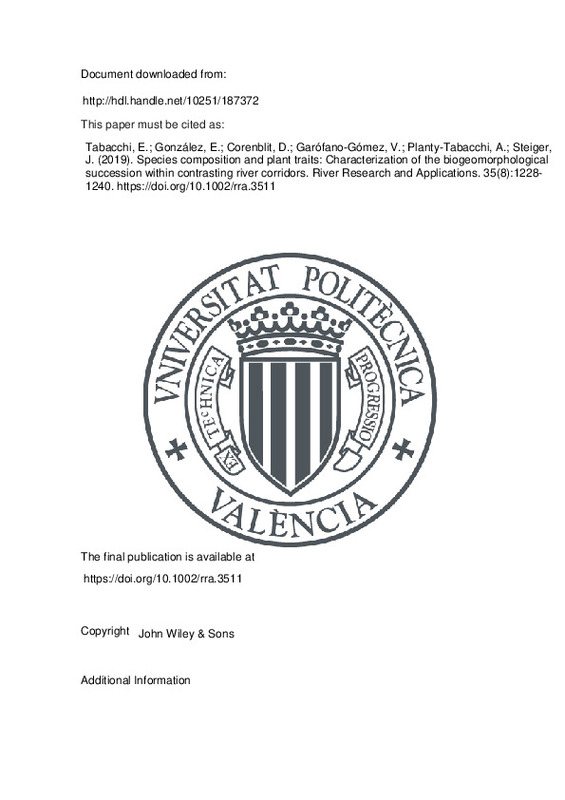JavaScript is disabled for your browser. Some features of this site may not work without it.
Buscar en RiuNet
Listar
Mi cuenta
Estadísticas
Ayuda RiuNet
Admin. UPV
Species composition and plant traits: Characterization of the biogeomorphological succession within contrasting river corridors
Mostrar el registro sencillo del ítem
Ficheros en el ítem
| dc.contributor.author | Tabacchi, Eric
|
es_ES |
| dc.contributor.author | González, Eduardo
|
es_ES |
| dc.contributor.author | Corenblit, Dov
|
es_ES |
| dc.contributor.author | Garófano-Gómez, Virginia
|
es_ES |
| dc.contributor.author | Planty-Tabacchi, Anne-Marie
|
es_ES |
| dc.contributor.author | Steiger, Johannes
|
es_ES |
| dc.date.accessioned | 2022-10-10T18:07:23Z | |
| dc.date.available | 2022-10-10T18:07:23Z | |
| dc.date.issued | 2019-10 | es_ES |
| dc.identifier.issn | 1535-1459 | es_ES |
| dc.identifier.uri | http://hdl.handle.net/10251/187372 | |
| dc.description.abstract | [EN] Plant communities and dynamics can be characterized according to species composition or plant traits. Here, we used species composition and plant traits to compare their effectiveness in discriminating the biogeomorphological (involving reciprocal feedbacks between physical and biological processes) and ecological (mainly biologically driven) phases of the fluvial biogeomorphological succession (FBS) model. The comparison was done between two French rivers, the largely unchannelized lower Allier and the channelized middle Garonne. One reach representative of each river section was selected for the study. Within each river reach, we chose two contrasted study sites in terms of channel and floodplain dynamics: a reference site (least altered channel and floodplain dynamics) and an altered site (laterally stabilized by riprap and constrained). In the four study sites, we sampled vegetation in 402 plots of 4 m2. The 512 species identified in the plots were characterized in terms of plant traits (20) from a literature review. When comparing reaches in unconstrained ordinations and per mutational multivariate analyses of variance, both species composition and plant traits led to a similar identification of the biogeomorphological and the ecological successional trajectories. Nevertheless, the trait approach was less influenced by local and regional bioclimatic, hydrogeomorphological, and anthropogenic settings and thus produced a more comprehensive and general classification of the biogeomorphological and ecological phases of the FBS model. A lower than expected contrast between the four sites was found, because neither species composition nor plant traits could entirely characterize distinct successional trajectories occurring in our reference or altered sites. Furthermore, our results contributed to a better understanding of the multiple successional trajectories that can occur in midlatitude river corridors. It also showed that relating plant traits to their effects on fluvial landform dynamics remains a core challenge in explaining succession including feedback mechanisms between hydrology, morphodynamics, and vegetation dynamics. | es_ES |
| dc.description.sponsorship | French National Centre of Scientific Research; French Ministry of Ecology, Environment, Sustainable Development and Planning | es_ES |
| dc.language | Inglés | es_ES |
| dc.publisher | John Wiley & Sons | es_ES |
| dc.relation.ispartof | River Research and Applications | es_ES |
| dc.rights | Reserva de todos los derechos | es_ES |
| dc.subject | Allier River | es_ES |
| dc.subject | Channelized | es_ES |
| dc.subject | Fluvial biogeomorphological succession | es_ES |
| dc.subject | Garonne River | es_ES |
| dc.subject | Plant traits | es_ES |
| dc.subject | Riparian vegetation | es_ES |
| dc.subject | Species composition | es_ES |
| dc.subject | Unchannelized | es_ES |
| dc.title | Species composition and plant traits: Characterization of the biogeomorphological succession within contrasting river corridors | es_ES |
| dc.type | Artículo | es_ES |
| dc.identifier.doi | 10.1002/rra.3511 | es_ES |
| dc.rights.accessRights | Abierto | es_ES |
| dc.contributor.affiliation | Universitat Politècnica de València. Instituto de Investigación para la Gestión Integral de Zonas Costeras - Institut d'Investigació per a la Gestió Integral de Zones Costaneres | es_ES |
| dc.description.bibliographicCitation | Tabacchi, E.; González, E.; Corenblit, D.; Garófano-Gómez, V.; Planty-Tabacchi, A.; Steiger, J. (2019). Species composition and plant traits: Characterization of the biogeomorphological succession within contrasting river corridors. River Research and Applications. 35(8):1228-1240. https://doi.org/10.1002/rra.3511 | es_ES |
| dc.description.accrualMethod | S | es_ES |
| dc.relation.publisherversion | https://doi.org/10.1002/rra.3511 | es_ES |
| dc.description.upvformatpinicio | 1228 | es_ES |
| dc.description.upvformatpfin | 1240 | es_ES |
| dc.type.version | info:eu-repo/semantics/publishedVersion | es_ES |
| dc.description.volume | 35 | es_ES |
| dc.description.issue | 8 | es_ES |
| dc.relation.pasarela | S\462070 | es_ES |
| dc.contributor.funder | Centre National de la Recherche Scientifique, Francia | es_ES |







![[Cerrado]](/themes/UPV/images/candado.png)

